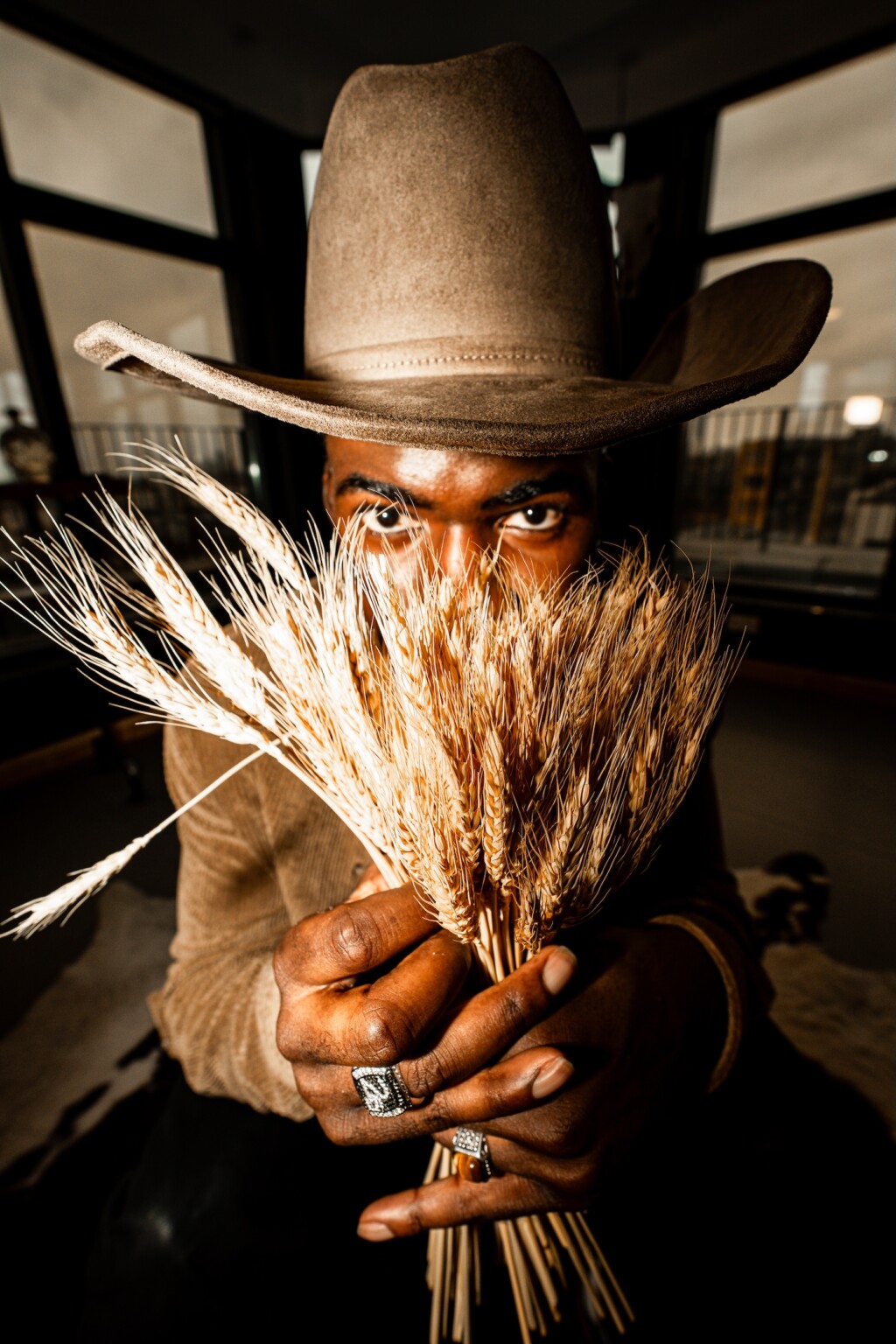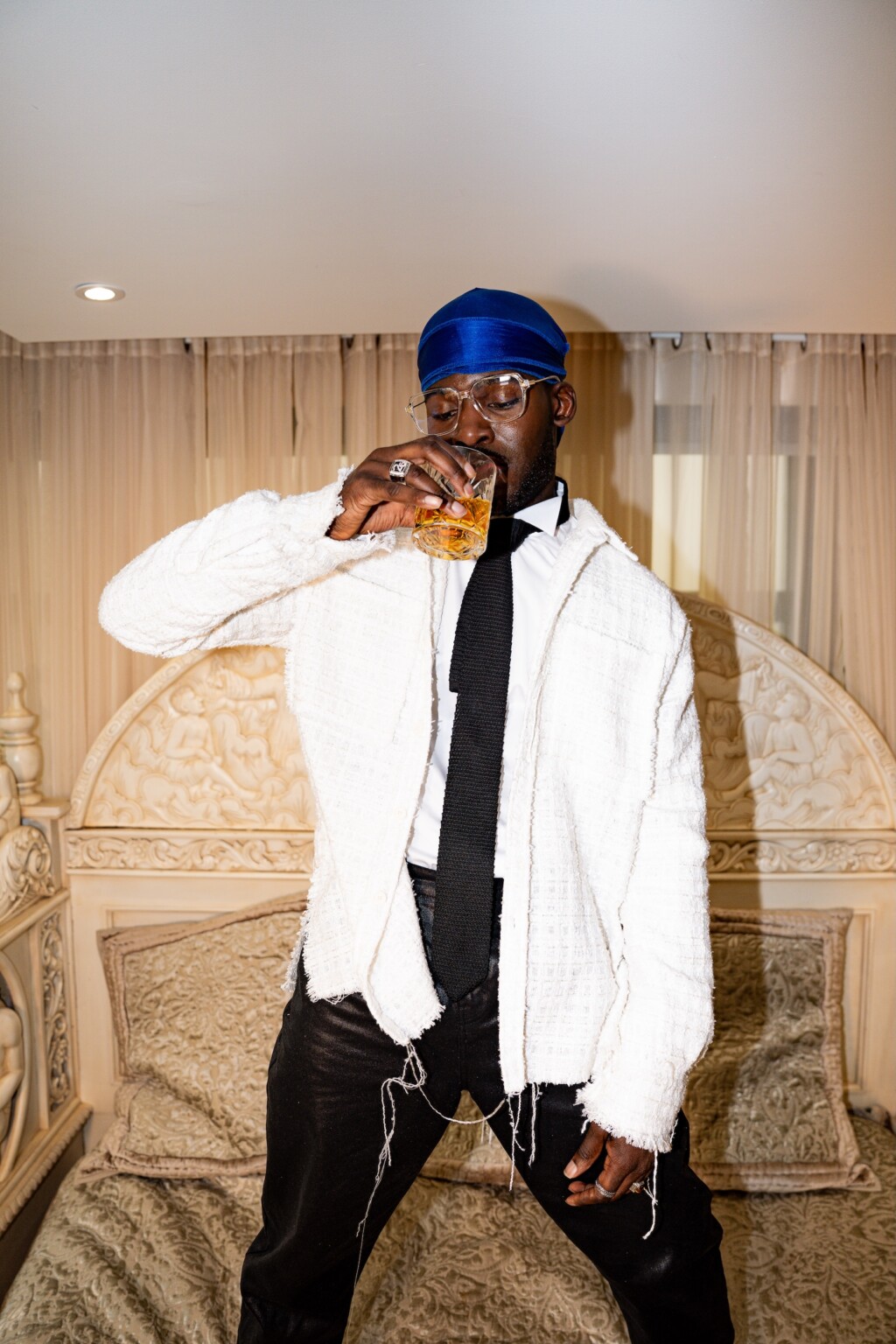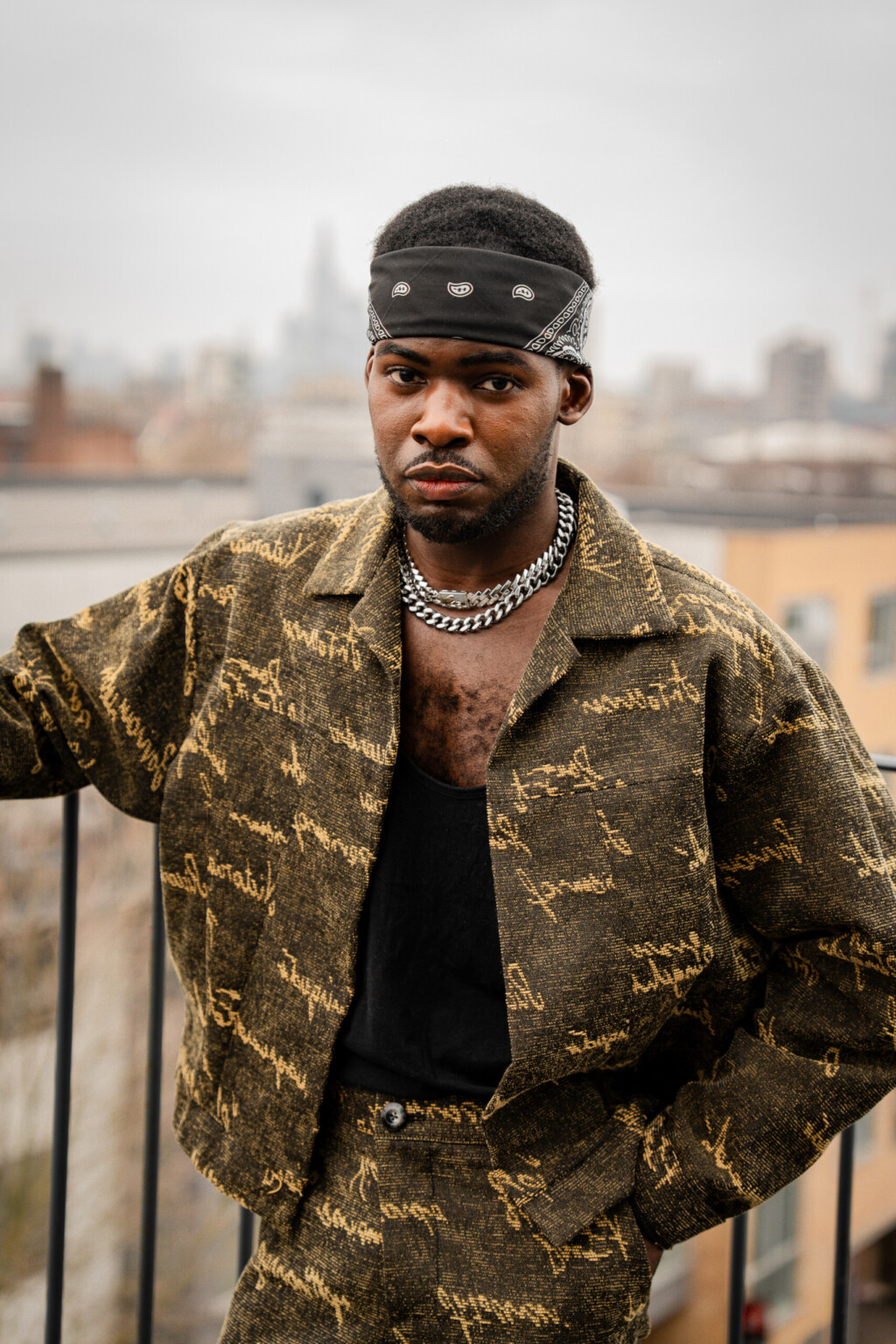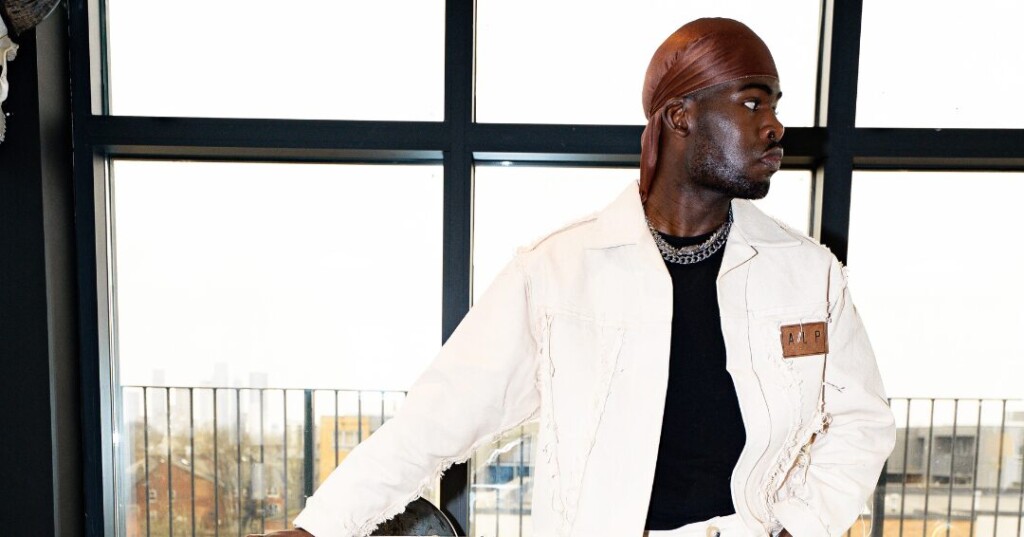Victor Olusina is working to make his mark as a storyteller and doesn’t plan to ask for permission. As a young British Nigerian, Olusina became curious about storytelling, which began with reading magazine articles about film. This initial interest eventually inspired him to dive into filmmaking. That small seed of inspiration led him to fall in love with acting and eventually, fashion as well.
From planting a seed rooted in passion and an incurable curiosity, Olusina eventually directed his first short film called Fraternité: Pillars of Us. This short film showcases the embodiment of what Black Brotherhood represents and the potential it can flourish into.
He also stars as Nico in The Johnny and Nico Show, which follows an adventure about two thieves, a clueless puppet, and a city-wide search for the priciest narcotics once owned by the most dangerous drug kingpin in Atlanta.
We caught up with Olusina to discuss directing his first short film, how we can change the stereotypes placed on young Black men, and how we can create a completely different standard for being a multi-hyphenate in today’s society.

How do you see your British-Nigerian heritage influencing your work in both fashion and film?
I was fortunate to grow up in a Nigerian household while experiencing British culture on the outside. That duality gave me a unique lens through which I see storytelling, particularly in how I want to bridge cultures. Nigerian culture instilled in me a deep sense of pride and a responsibility to tell stories that reflect my Yoruba heritage.
At the same time, being British-Nigerian allows me to bring those stories to a wider audience—whether through film, fashion, or other creative spaces. I see it as a beautifully balanced cultural identity that gives me a unique perspective in both industries.
Can you tell us about the inspiration behind Fraternité: Pillars of Us?
Last October, during a season of deep reflection and creative brainstorming, I experienced a personal betrayal by someone I deeply trusted. It was a very painful period that made me feel isolated like I couldn’t lean on anyone. That experience, however, led me to truly understand the power of Brotherhood—the importance of having people you can turn to in moments of vulnerability.
Fraternité: Pillars of Us was born from that revelation. It became a form of poetic justice, turning pain into purpose by telling a story about emotional expression, resilience, and the unspoken strength within Black Male Friendships.
Fraternité: Pillars of Us challenges stereotypes and offers a new narrative on Black male identity. What personal experiences or insights did you bring into this project?
My biggest personal experience was navigating the pain of betrayal. It’s never easy when someone shows their true colors at the exact moment you choose to be vulnerable with them. That type of pain can make you question everything. But through that, I found Brotherhood in a way I hadn’t before—I learned that healing comes from shared experiences and honest conversations. That’s the energy I brought into this project, showing that Black Men can lean on each other, listen to each other, and find strength in vulnerability.
The concept of brotherhood and the pressures placed on Black men is a powerful theme. What do you hope audiences take away from the editorial?
I want audiences to walk away with a new perspective on Black men—one that acknowledges our humanity. Society often tells us to “man up” and suppress our emotions, but that expectation is damaging. We feel, we struggle, we go through hardships just like everyone else. Instead of being told to “suck it up,” Black men deserve spaces to be vulnerable without fear of judgment. I hope this editorial sparks conversations about emotional expression and challenges the toxic expectations placed on us.
Fraternité Pillars of Us blends elements of fashion, visual storytelling, and cultural commentary. How did you ensure these elements worked together cohesively?
The key to ensuring these elements worked together cohesively was having a clear and unified vision from the start. I wanted Fraternité Pillars of Us to feel like more than just a fashion piece. It had to be a visual and emotional experience that carried a strong narrative. The styling played an essential role in reinforcing that vision, and I was fortunate to have the incredible talents of Angela Gaote, Kwon Hepburn, and Taylan Holness as the glue that held the execution together.
You’ve had an incredible journey from directing to acting. What sparked your initial passion for filmmaking, and how did that evolve into stepping in front of the camera?
From a young age, I was fascinated by the art of storytelling. I would spend hours reading magazine articles about filmmakers and watching behind-the-scenes extras on movies, trying to understand what went into creating a body of work. There was something magical about seeing a vision come to life, from an idea to a fully realized piece of art. That curiosity eventually led me to try both sides of the camera—I wanted to tell stories not just from behind the lens but also as someone embodying them. Acting became a natural extension of that passion, allowing me to step deeper into the stories I wanted to tell.
What has been the most surprising or challenging aspect of transitioning from directing to acting?
The most surprising and challenging part of the transition is understanding my role within a production. As a director, I’m used to being in control of the bigger picture—overseeing everything from storyboarding to the final cut. As an actor, my focus shifts entirely to the character and trusting the director’s vision.
I’ll always have ideas, no matter what project I’m part of, but when I’m strictly acting, I have to accept that my creative input won’t always make the final cut. That can be both freeing and frustrating, but ultimately, it’s about embracing the different dynamics of storytelling.
How do you approach storytelling differently when you’re directing versus when you’re acting?
Acting, for me, is more instinctive and immersive. I love getting my sides each week, diving into the script, and building backstories and nuances that bring the character to life. There’s also something special about collaborating with fellow cast members and seeing how everyone’s interpretations come together—it’s truly magical.
Directing, on the other hand, requires a different mindset. My focus is on the bigger picture: making sure shots are clean, ensuring every department is working cohesively, and guiding the overall vision. It’s a leadership role that I equally enjoy, but it comes with a different set of responsibilities. With acting, I get to play in the moment; with directing, I’m orchestrating how those moments are captured.
How do you see the connection between fashion and filmmaking— both directing and acting—in your creative work?
Fashion and filmmaking are both about storytelling. In film, we tell stories through dialogue, performance, and cinematography. In fashion, we tell stories through fabric, movement, and aesthetics. The two are deeply connected. Whether I’m directing an editorial or stepping into a film role, I’m always thinking about how visual language influences perception. Clothes are an extension of character, identity, and emotion—they set the tone just as much as cinematography does in a film.

Many emerging creatives struggle with being boxed into one artistic lane. What advice would you give to others who want to explore multiple creative fields?
Don’t be afraid to redefine yourself. People will always try to categorize you, but the most successful creatives are those who refuse to be put in a box. If you have multiple talents, nurture them. Whether it’s film, fashion, music, or beyond—each skill set will enhance the other. The key is to be intentional with your growth and make sure you’re delivering quality in every space you step into.
Brand partnerships were also instrumental in elevating the concept.
Denzilpatrick, Gravalot, and Lydiah Holder were the best possible collaborators to help take this idea of Black Brotherhood and shape it into something deeply resonant. Their designs carried a sense of heritage, strength, and elegance, all of which perfectly complemented the story I wanted to tell.
Most importantly, the foundation of Fraternité Pillars of Us was built on the idea of unity—challenging the stereotypes often placed on Black men and showcasing a collective strength in vulnerability. Every model who stepped into this project understood the weight of what we were trying to create. Seeing the right cast and crew come together with the same passion and ambition was a deeply fulfilling moment, and it’s what ultimately made this piece as powerful as it became.
You’re stepping into your first major on-screen role with The Johnny & Nico Show. Can you tell us a bit about the series and your character?
Without revealing too much, The Johnny & Nico Show is a dynamic crime comedy series that has already had an incredible festival run, with critics drawing comparisons to Kenan & Kel. As someone who grew up loving that show, that’s a huge honor. I play Nico, one-half of the central duo, and I can’t wait for audiences to see the chemistry and chaos that unfolds.
As someone coming from the UK film scene, how has it been adjusting to working on an American production?
Filming in Atlanta for the pilot was an amazing experience. From day one, I felt a warm, supportive network around me. Production-wise, I don’t see a huge difference between UK and US sets, but I will say—I definitely prefer American craft services! If I’m not on set filming, you’ll probably find me at the snack table.

If you could collaborate with any director or actor in the world, who would it be and why?
Jamie Foxx, hands down. He’s the epitome of versatility—acting, comedy, music, impressions, he does it all. I’ve always admired his range, and as someone who also dances and performs across multiple disciplines, I see him as the gold standard. I hope to reach that level one day.
What upcoming projects can we look forward to from you?
After The Johnny & Nico Show, I have several feature films lined up, which perfectly align with where the series leaves off. I love planting easter eggs in my work, so audiences should keep an eye out. Outside of film, I’ve been quietly developing a fashion brand for six years, waiting for the right moment to launch. Like Zendaya, I want to make a significant impact in both fashion and film, showcasing my best work in both industries.
Sometimes we have people who inspire us, but you are the first YOU. What type of example do you want to set for other young men/creatives?
I want to set the example that you don’t have to fit into a single box to be successful. There’s no blueprint that says you have to follow a set path—your creativity is yours to shape, and your journey is meant to be unique.
Perseverance is everything in this industry. There will be setbacks, people who doubt you, and moments when you question yourself, but if you stay true to your vision and work with integrity, everything will align in due time. I hope to show young men, especially those coming from backgrounds where opportunities feel limited, that they can break through any barriers placed in front of them.
More than anything, I want to inspire others to create fearlessly. Whether it’s in fashion, film, music, or any other creative space, the world is waiting for your story, your voice, and your perspective. There’s power in that.




